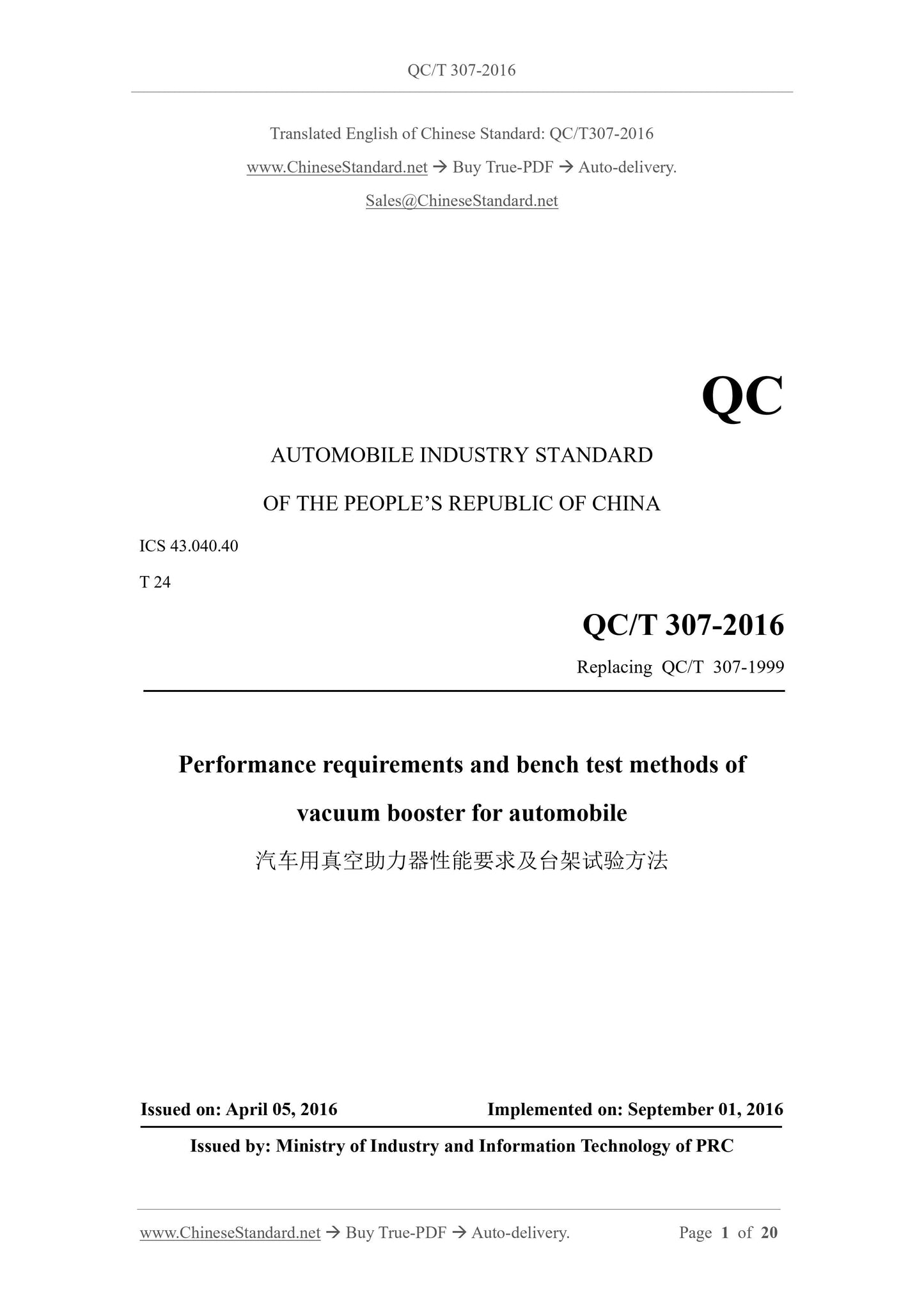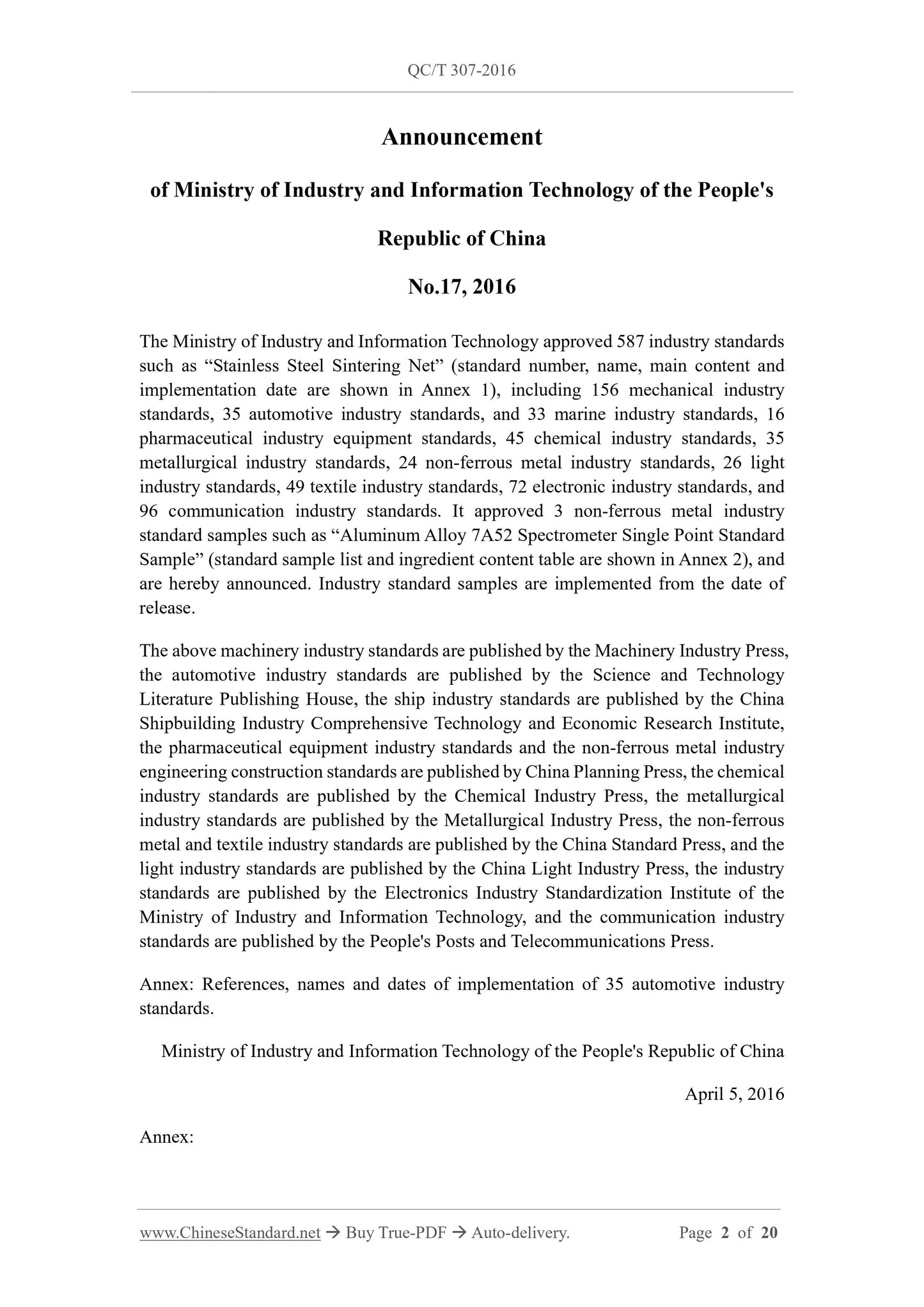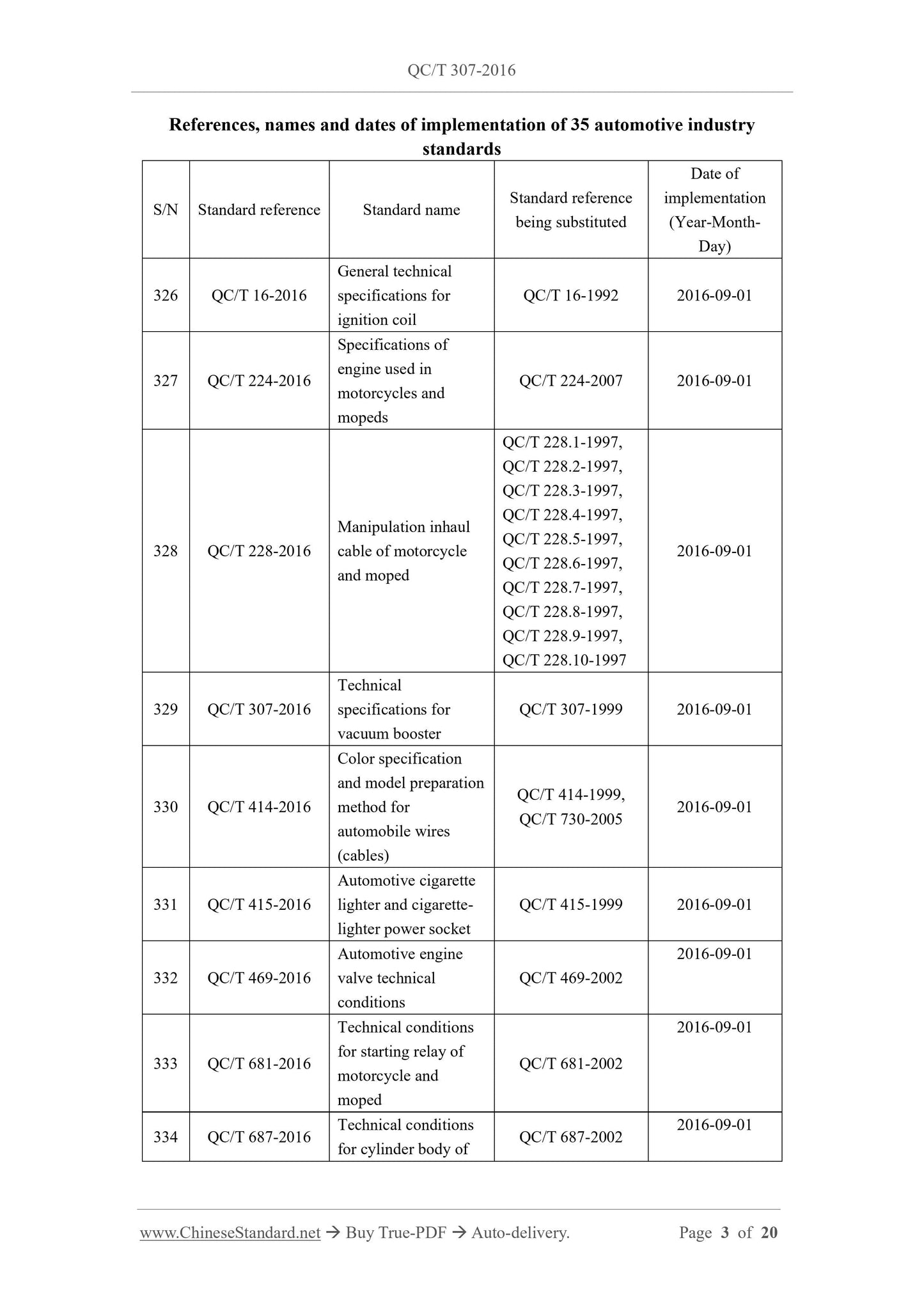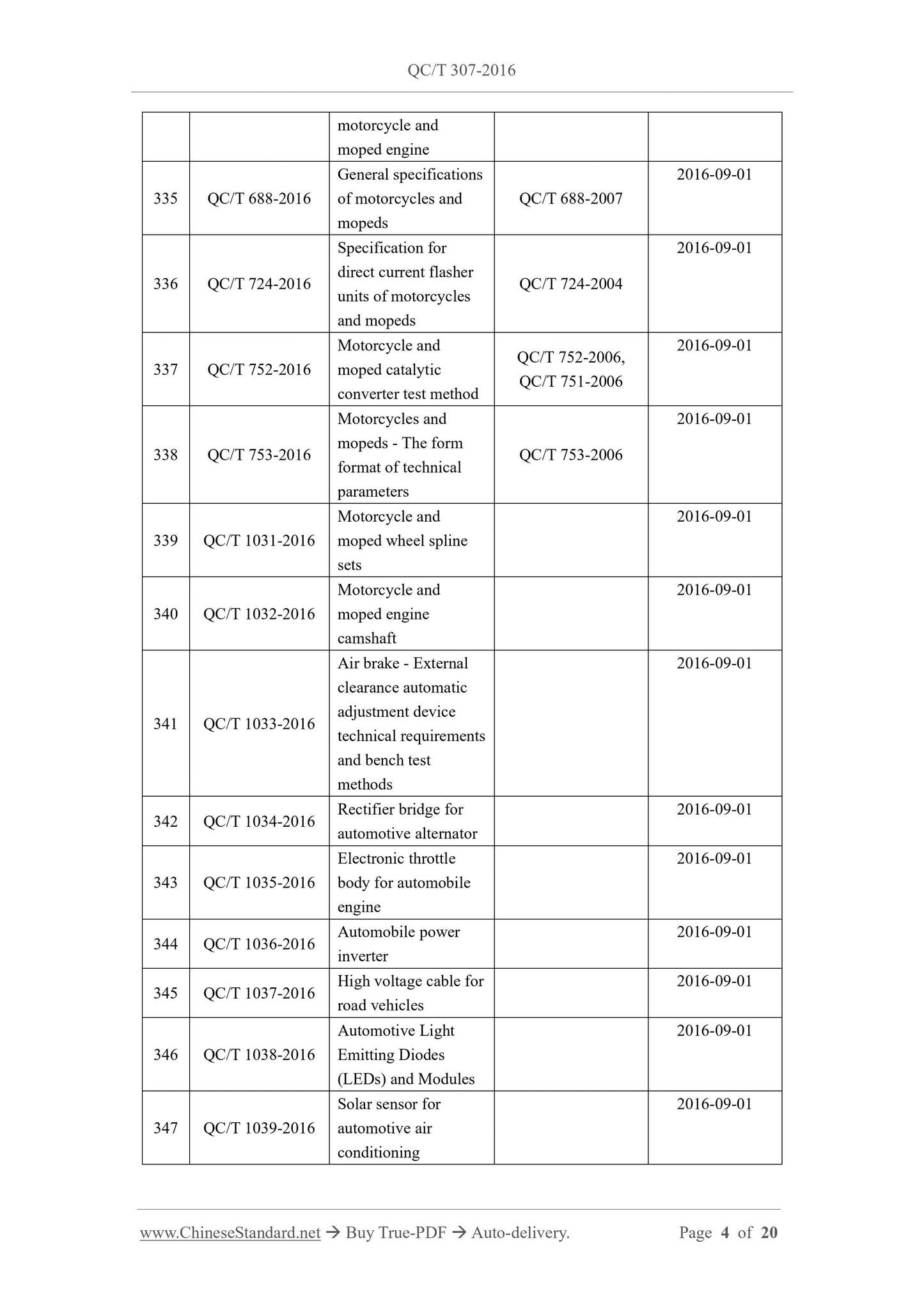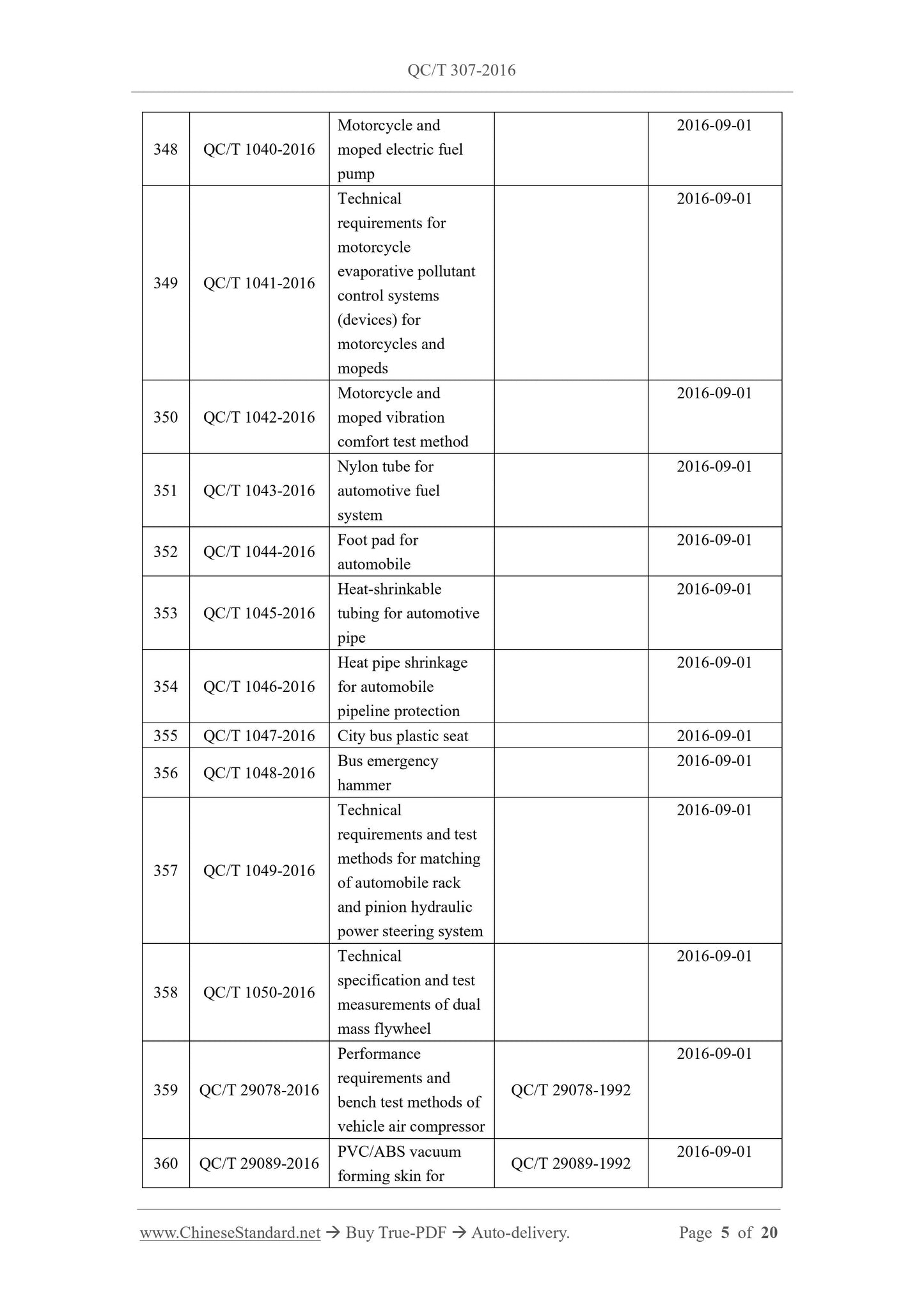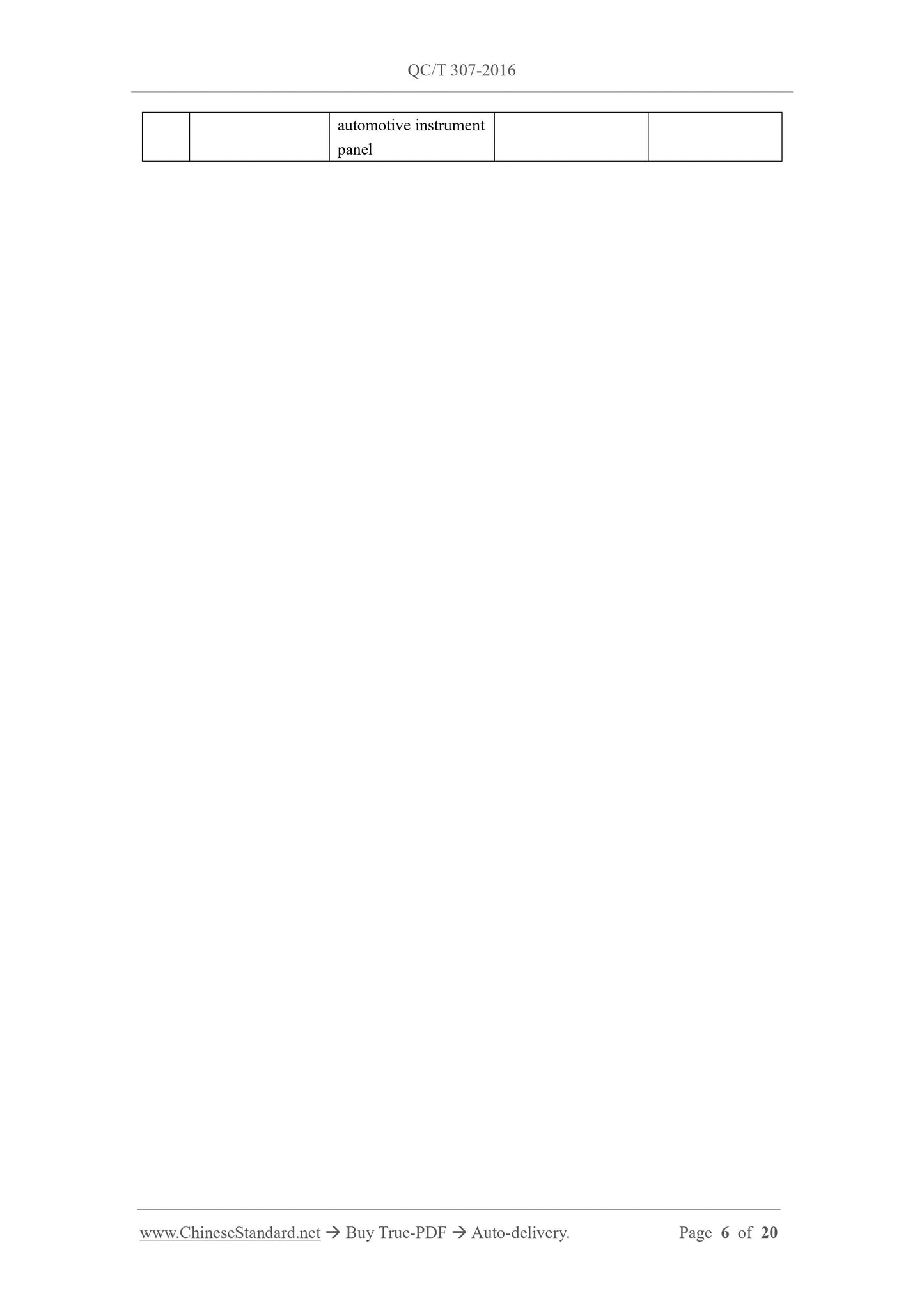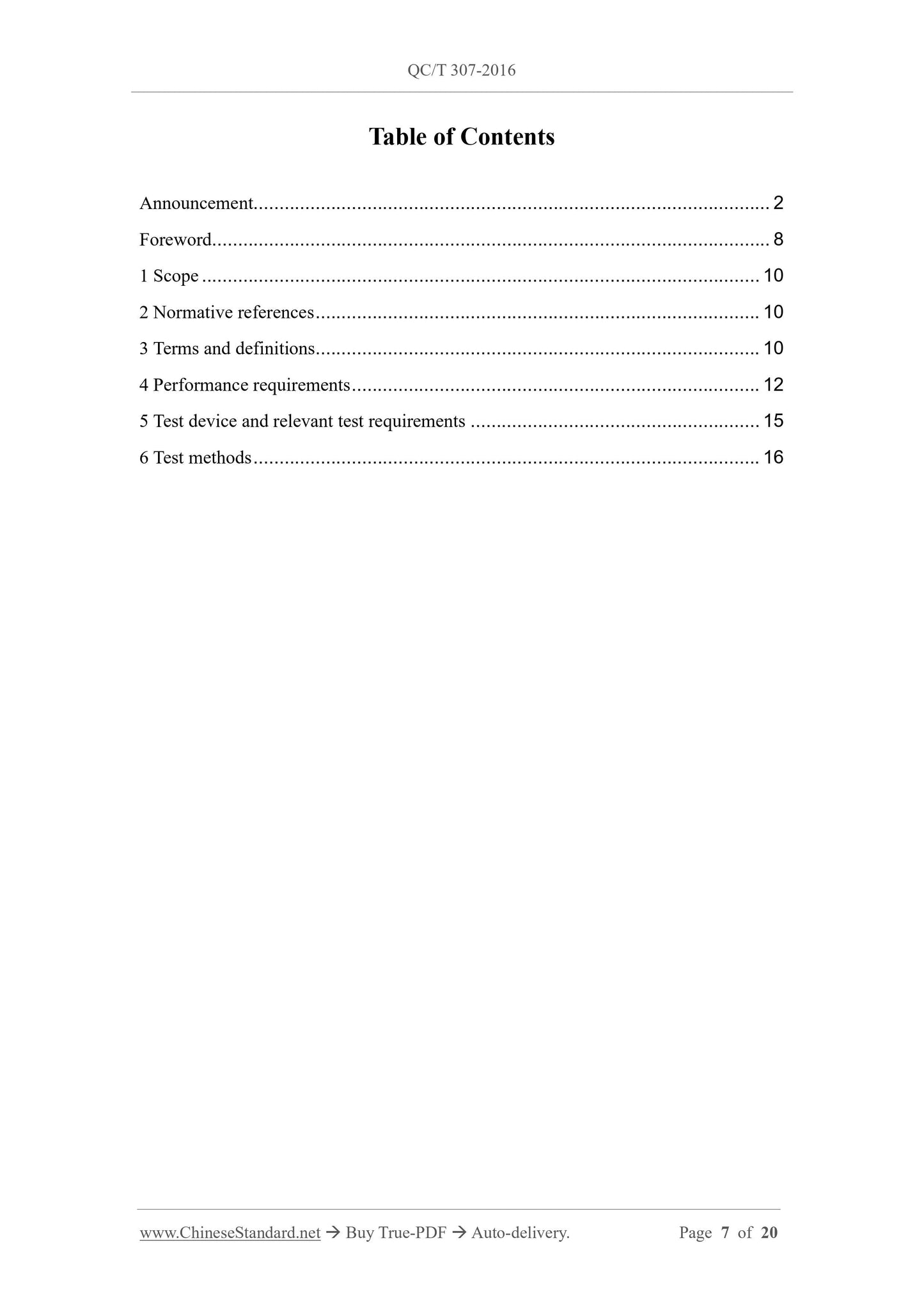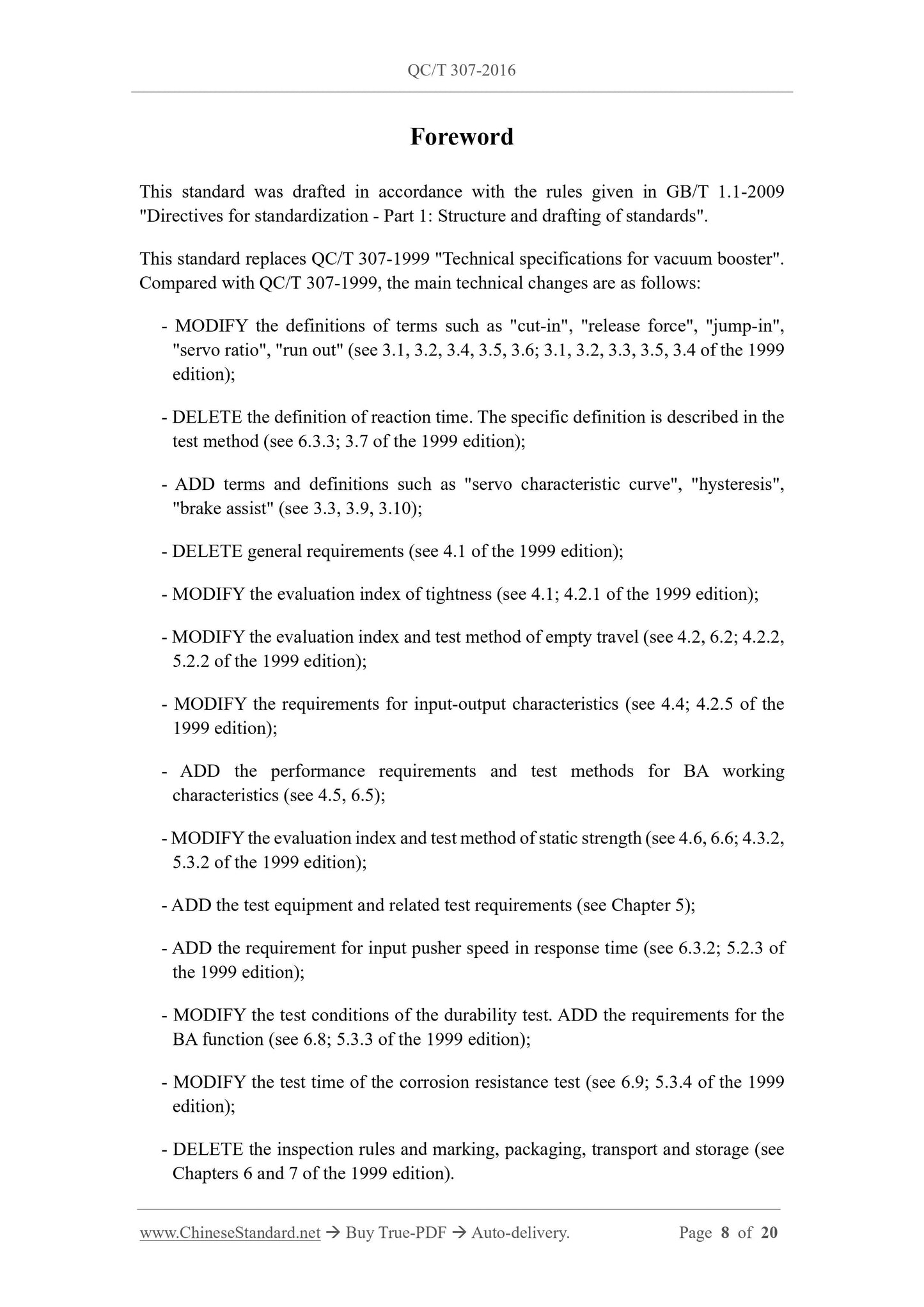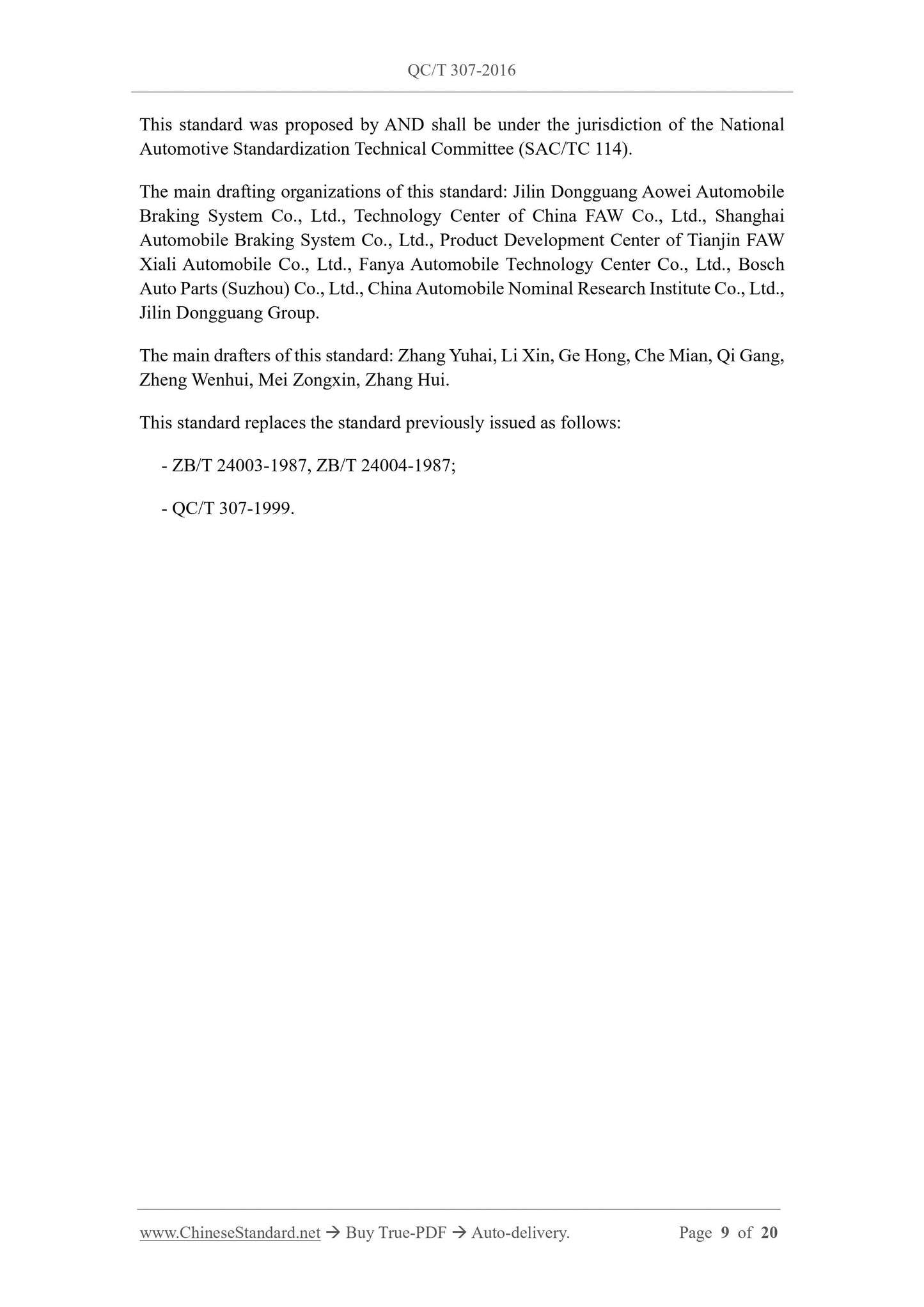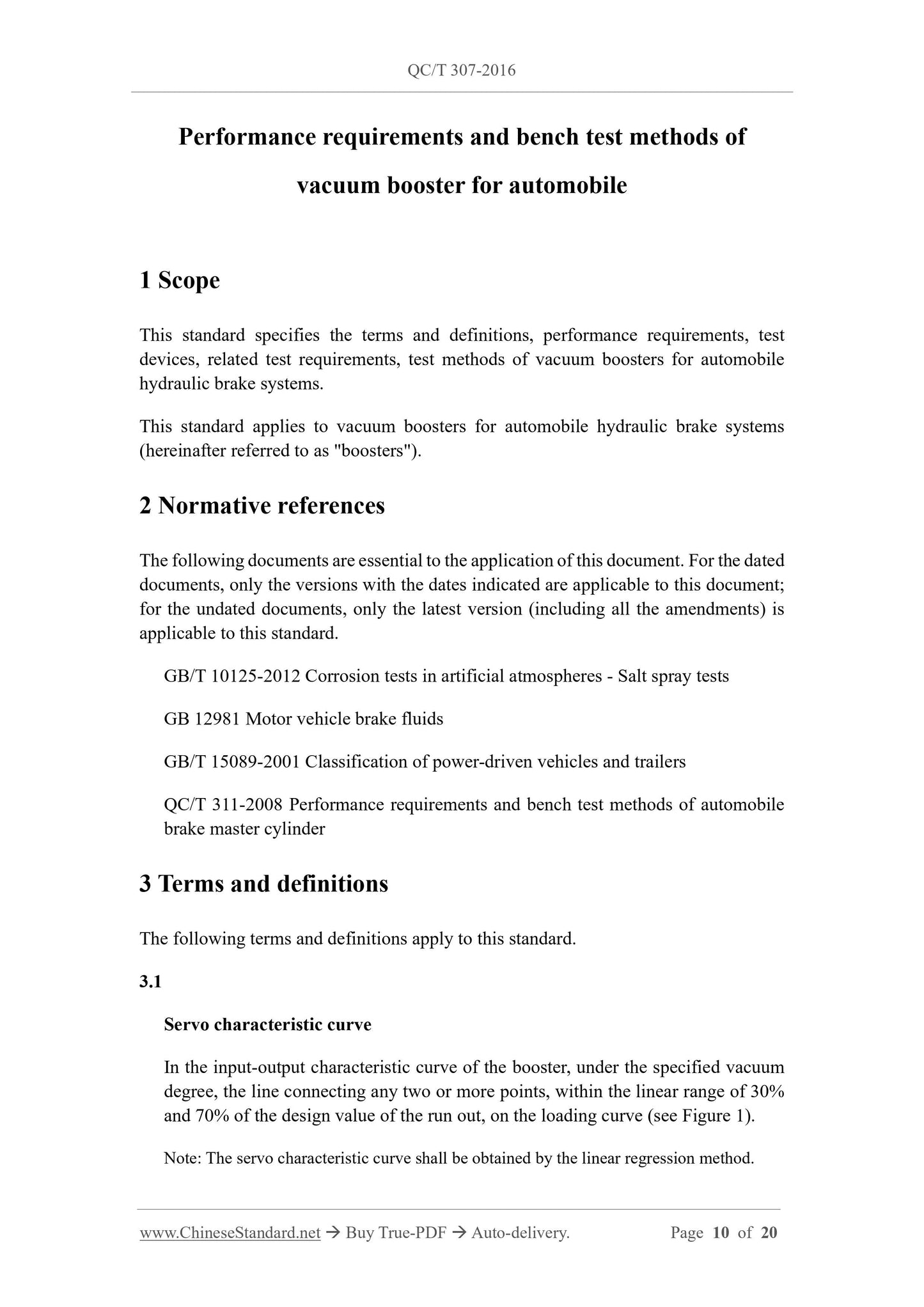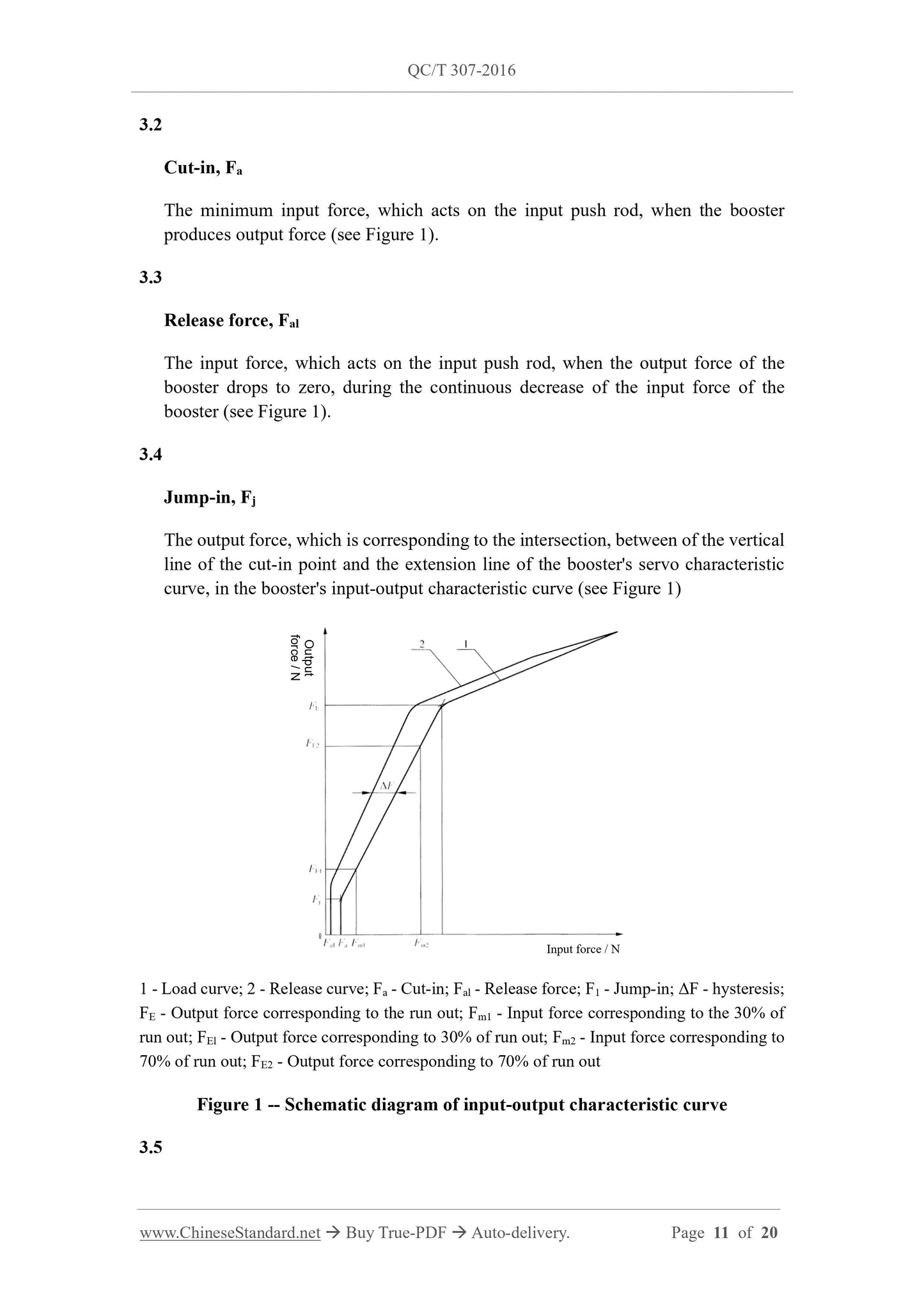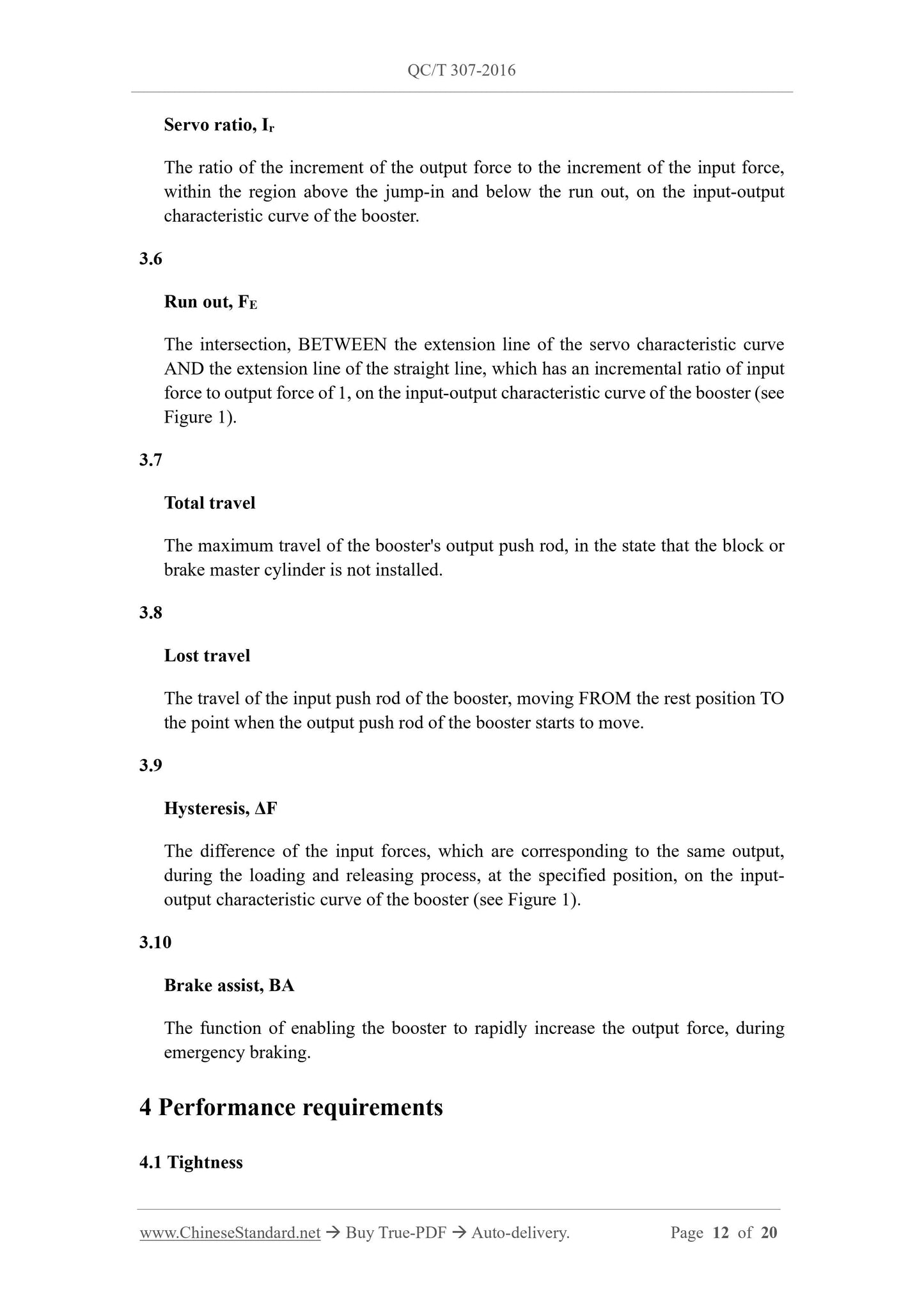1
/
of
12
PayPal, credit cards. Download editable-PDF & invoice in 1 second!
QC/T 307-2016 English PDF (QCT307-2016)
QC/T 307-2016 English PDF (QCT307-2016)
Regular price
$105.00 USD
Regular price
Sale price
$105.00 USD
Unit price
/
per
Shipping calculated at checkout.
Couldn't load pickup availability
Delivery: 3 seconds. Download true-PDF + Invoice.
Get QUOTATION in 1-minute: Click QC/T 307-2016
Historical versions: QC/T 307-2016
Preview True-PDF (Reload/Scroll if blank)
QC/T 307-2016: Performance requirements and bench test methods of vacuum booster for automobile
QC/T 307-2016
AUTOMOBILE INDUSTRY STANDARD
OF THE PEOPLE’S REPUBLIC OF CHINA
ICS 43.040.40
T 24
Replacing QC/T 307-1999
Performance requirements and bench test methods of
vacuum booster for automobile
ISSUED ON: APRIL 05, 2016
IMPLEMENTED ON: SEPTEMBER 01, 2016
Issued by: Ministry of Industry and Information Technology of PRC
Table of Contents
Announcement... 2
Foreword ... 8
1 Scope ... 10
2 Normative references ... 10
3 Terms and definitions... 10
4 Performance requirements ... 12
5 Test device and relevant test requirements ... 15
6 Test methods ... 16
Foreword
This standard was drafted in accordance with the rules given in GB/T 1.1-2009
"Directives for standardization - Part 1: Structure and drafting of standards".
This standard replaces QC/T 307-1999 "Technical specifications for vacuum booster".
Compared with QC/T 307-1999, the main technical changes are as follows:
- MODIFY the definitions of terms such as "cut-in", "release force", "jump-in",
"servo ratio", "run out" (see 3.1, 3.2, 3.4, 3.5, 3.6; 3.1, 3.2, 3.3, 3.5, 3.4 of the 1999
edition);
- DELETE the definition of reaction time. The specific definition is described in the
test method (see 6.3.3; 3.7 of the 1999 edition);
- ADD terms and definitions such as "servo characteristic curve", "hysteresis",
"brake assist" (see 3.3, 3.9, 3.10);
- DELETE general requirements (see 4.1 of the 1999 edition);
- MODIFY the evaluation index of tightness (see 4.1; 4.2.1 of the 1999 edition);
- MODIFY the evaluation index and test method of empty travel (see 4.2, 6.2; 4.2.2,
5.2.2 of the 1999 edition);
- MODIFY the requirements for input-output characteristics (see 4.4; 4.2.5 of the
1999 edition);
- ADD the performance requirements and test methods for BA working
characteristics (see 4.5, 6.5);
- MODIFY the evaluation index and test method of static strength (see 4.6, 6.6; 4.3.2,
5.3.2 of the 1999 edition);
- ADD the test equipment and related test requirements (see Chapter 5);
- ADD the requirement for input pusher speed in response time (see 6.3.2; 5.2.3 of
the 1999 edition);
- MODIFY the test conditions of the durability test. ADD the requirements for the
BA function (see 6.8; 5.3.3 of the 1999 edition);
- MODIFY the test time of the corrosion resistance test (see 6.9; 5.3.4 of the 1999
edition);
- DELETE the inspection rules and marking, packaging, transport and storage (see
Chapters 6 and 7 of the 1999 edition).
Performance requirements and bench test methods of
vacuum booster for automobile
1 Scope
This standard specifies the terms and definitions, performance requirements, test
devices, related test requirements, test methods of vacuum boosters for automobile
hydraulic brake systems.
This standard applies to vacuum boosters for automobile hydraulic brake systems
(hereinafter referred to as "boosters").
2 Normative references
The following documents are essential to the application of this document. For the dated
documents, only the versions with the dates indicated are applicable to this document;
for the undated documents, only the latest version (including all the amendments) is
applicable to this standard.
GB/T 10125-2012 Corrosion tests in artificial atmospheres - Salt spray tests
GB 12981 Motor vehicle brake fluids
GB/T 15089-2001 Classification of power-driven vehicles and trailers
QC/T 311-2008 Performance requirements and bench test methods of automobile
brake master cylinder
3 Terms and definitions
The following terms and definitions apply to this standard.
3.1
Servo characteristic curve
In the input-output characteristic curve of the booster, under the specified vacuum
degree, the line connecting any two or more points, within the linear range of 30%
and 70% of the design value of the run out, on the loading curve (see Figure 1).
Note: The servo characteristic curve shall be obtained by the linear regression method.
Servo ratio, Ir
The ratio of the increment of the output force to the increment of the input force,
within the region above the jump-in and below the run out, on the input-output
characteristic curve of the booster.
3.6
Run out, FE
The intersection, BETWEEN the extension line of the servo characteristic curve
AND the extension line of the straight line, which has an incremental ratio of input
force to output force of 1, on the input-output characteristic curve of the booster (see
Figure 1).
3.7
Total travel
The maximum travel of the booster's output push rod, in the state that the block or
brake master cylinder is not installed.
3.8
Lost travel
The travel of the input push rod of the booster, moving FROM the rest position TO
the point when the output push rod of the booster starts to move.
3.9
Hysteresis, ΔF
The difference of the input forces, which are corresponding to the same output,
during the loading and releasing process, at the specified position, on the input-
output characteristic curve of the booster (see Figure 1).
3.10
Brake assist, BA
The function of enabling the booster to rapidly increase the output force, during
emergency braking.
4 Performance requirements
4.1 Tightness
d) Input-output characteristics shall comply with the provisions of 4.4.
4.8 Working durability
After the booster has undergone the durability test, it shall meet the following
requirements:
a) The surface of the shell shall be free from cracks and deformations, which affect
the function;
b) The tightening torque of the bolt or nut, at the connection part of the booster, shall
not be lower than 50% of that before the test;
c) The tightness shall meet the requirements of 4.1;
d) The input-output characteristics shall comply with the provisions of 4.4.
4.9 Corrosion resistance
The booster shall meet the requirements of Table 5, after the corrosion resistance test.
5 Test device and relevant test requirements
5.1 Test device
5.1.1 The included angle, between the push rod of the drive device and the input push
rod of the booster, shall not be greater than 3.5°. The input push rod of the booster shall
be able to return quickly. During periodic work, the loading frequency and rate can be
adjusted, according to the test requirements.
5.1.2 When the vacuum tightness test is carried out, the total effective volume of the
test loop is (500 ± 50) mL.
6.2 Lost travel
Install the booster on the test bench. Push the input push rod at a speed of (0.2 ± 0.1)
mm/s, under the vacuum condition of (-66.7 ± 1.3) kPa. Measure the displacement of
the input push rod, when the output push rod of the booster moves.
6.3 Response time and release time
6.3.1 Install the booster on the test bench. Adjust the output load or block of the booster,
under the vacuum condition of (-66.7 ± 1.3) kPa, so that when the travel of the input
push rod reaches 50% ~ 70% of the full travel, the output force reaches more than 130%
of the run out.
6.3.2 Push the input push rod of the booster, at a speed of not less than 350 mm/s, so
that the output force of the booster reaches 130% of the run out; after holding for at
least 2 s, quickly release the force on the input push rod, to make the input push rod
return automatically.
6.3.3 During the test, measure the time, from applying force to reaching 97% of the run
out (i.e., response time), AND from releasing the input force of the push rod to the time
when the output force drops to 10% of the ...
Get QUOTATION in 1-minute: Click QC/T 307-2016
Historical versions: QC/T 307-2016
Preview True-PDF (Reload/Scroll if blank)
QC/T 307-2016: Performance requirements and bench test methods of vacuum booster for automobile
QC/T 307-2016
AUTOMOBILE INDUSTRY STANDARD
OF THE PEOPLE’S REPUBLIC OF CHINA
ICS 43.040.40
T 24
Replacing QC/T 307-1999
Performance requirements and bench test methods of
vacuum booster for automobile
ISSUED ON: APRIL 05, 2016
IMPLEMENTED ON: SEPTEMBER 01, 2016
Issued by: Ministry of Industry and Information Technology of PRC
Table of Contents
Announcement... 2
Foreword ... 8
1 Scope ... 10
2 Normative references ... 10
3 Terms and definitions... 10
4 Performance requirements ... 12
5 Test device and relevant test requirements ... 15
6 Test methods ... 16
Foreword
This standard was drafted in accordance with the rules given in GB/T 1.1-2009
"Directives for standardization - Part 1: Structure and drafting of standards".
This standard replaces QC/T 307-1999 "Technical specifications for vacuum booster".
Compared with QC/T 307-1999, the main technical changes are as follows:
- MODIFY the definitions of terms such as "cut-in", "release force", "jump-in",
"servo ratio", "run out" (see 3.1, 3.2, 3.4, 3.5, 3.6; 3.1, 3.2, 3.3, 3.5, 3.4 of the 1999
edition);
- DELETE the definition of reaction time. The specific definition is described in the
test method (see 6.3.3; 3.7 of the 1999 edition);
- ADD terms and definitions such as "servo characteristic curve", "hysteresis",
"brake assist" (see 3.3, 3.9, 3.10);
- DELETE general requirements (see 4.1 of the 1999 edition);
- MODIFY the evaluation index of tightness (see 4.1; 4.2.1 of the 1999 edition);
- MODIFY the evaluation index and test method of empty travel (see 4.2, 6.2; 4.2.2,
5.2.2 of the 1999 edition);
- MODIFY the requirements for input-output characteristics (see 4.4; 4.2.5 of the
1999 edition);
- ADD the performance requirements and test methods for BA working
characteristics (see 4.5, 6.5);
- MODIFY the evaluation index and test method of static strength (see 4.6, 6.6; 4.3.2,
5.3.2 of the 1999 edition);
- ADD the test equipment and related test requirements (see Chapter 5);
- ADD the requirement for input pusher speed in response time (see 6.3.2; 5.2.3 of
the 1999 edition);
- MODIFY the test conditions of the durability test. ADD the requirements for the
BA function (see 6.8; 5.3.3 of the 1999 edition);
- MODIFY the test time of the corrosion resistance test (see 6.9; 5.3.4 of the 1999
edition);
- DELETE the inspection rules and marking, packaging, transport and storage (see
Chapters 6 and 7 of the 1999 edition).
Performance requirements and bench test methods of
vacuum booster for automobile
1 Scope
This standard specifies the terms and definitions, performance requirements, test
devices, related test requirements, test methods of vacuum boosters for automobile
hydraulic brake systems.
This standard applies to vacuum boosters for automobile hydraulic brake systems
(hereinafter referred to as "boosters").
2 Normative references
The following documents are essential to the application of this document. For the dated
documents, only the versions with the dates indicated are applicable to this document;
for the undated documents, only the latest version (including all the amendments) is
applicable to this standard.
GB/T 10125-2012 Corrosion tests in artificial atmospheres - Salt spray tests
GB 12981 Motor vehicle brake fluids
GB/T 15089-2001 Classification of power-driven vehicles and trailers
QC/T 311-2008 Performance requirements and bench test methods of automobile
brake master cylinder
3 Terms and definitions
The following terms and definitions apply to this standard.
3.1
Servo characteristic curve
In the input-output characteristic curve of the booster, under the specified vacuum
degree, the line connecting any two or more points, within the linear range of 30%
and 70% of the design value of the run out, on the loading curve (see Figure 1).
Note: The servo characteristic curve shall be obtained by the linear regression method.
Servo ratio, Ir
The ratio of the increment of the output force to the increment of the input force,
within the region above the jump-in and below the run out, on the input-output
characteristic curve of the booster.
3.6
Run out, FE
The intersection, BETWEEN the extension line of the servo characteristic curve
AND the extension line of the straight line, which has an incremental ratio of input
force to output force of 1, on the input-output characteristic curve of the booster (see
Figure 1).
3.7
Total travel
The maximum travel of the booster's output push rod, in the state that the block or
brake master cylinder is not installed.
3.8
Lost travel
The travel of the input push rod of the booster, moving FROM the rest position TO
the point when the output push rod of the booster starts to move.
3.9
Hysteresis, ΔF
The difference of the input forces, which are corresponding to the same output,
during the loading and releasing process, at the specified position, on the input-
output characteristic curve of the booster (see Figure 1).
3.10
Brake assist, BA
The function of enabling the booster to rapidly increase the output force, during
emergency braking.
4 Performance requirements
4.1 Tightness
d) Input-output characteristics shall comply with the provisions of 4.4.
4.8 Working durability
After the booster has undergone the durability test, it shall meet the following
requirements:
a) The surface of the shell shall be free from cracks and deformations, which affect
the function;
b) The tightening torque of the bolt or nut, at the connection part of the booster, shall
not be lower than 50% of that before the test;
c) The tightness shall meet the requirements of 4.1;
d) The input-output characteristics shall comply with the provisions of 4.4.
4.9 Corrosion resistance
The booster shall meet the requirements of Table 5, after the corrosion resistance test.
5 Test device and relevant test requirements
5.1 Test device
5.1.1 The included angle, between the push rod of the drive device and the input push
rod of the booster, shall not be greater than 3.5°. The input push rod of the booster shall
be able to return quickly. During periodic work, the loading frequency and rate can be
adjusted, according to the test requirements.
5.1.2 When the vacuum tightness test is carried out, the total effective volume of the
test loop is (500 ± 50) mL.
6.2 Lost travel
Install the booster on the test bench. Push the input push rod at a speed of (0.2 ± 0.1)
mm/s, under the vacuum condition of (-66.7 ± 1.3) kPa. Measure the displacement of
the input push rod, when the output push rod of the booster moves.
6.3 Response time and release time
6.3.1 Install the booster on the test bench. Adjust the output load or block of the booster,
under the vacuum condition of (-66.7 ± 1.3) kPa, so that when the travel of the input
push rod reaches 50% ~ 70% of the full travel, the output force reaches more than 130%
of the run out.
6.3.2 Push the input push rod of the booster, at a speed of not less than 350 mm/s, so
that the output force of the booster reaches 130% of the run out; after holding for at
least 2 s, quickly release the force on the input push rod, to make the input push rod
return automatically.
6.3.3 During the test, measure the time, from applying force to reaching 97% of the run
out (i.e., response time), AND from releasing the input force of the push rod to the time
when the output force drops to 10% of the ...
Share
